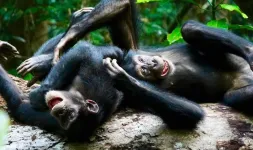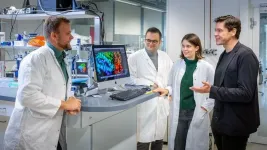(Press-News.org)
Photos
Morning glory plants that can resist the effects of glyphosate also resist damage from herbivorous insects, according to a University of Michigan study.
The U-M researchers also found the reverse: plants treated with and susceptible to glyphosate, the active ingredient in the herbicide RoundUp, are also susceptible to damage from insects. This suggests that glyphosate, a herbicide humans have introduced into the environment, can disrupt the co-evolution of plants and their insect herbivores. Their results are published in the journal New Phytologist.
"When people think about herbicides and study them in plants, they think about herbicide resistance. Resistance is a big problem, tolerance is a big problem," said lead author Grace Zhang, a U-M doctoral student working with Regina Baucom, a professor in the Department of Ecology and Evolutionary Biology. "But beyond that, we don't really have a great idea of how herbicides impact plant evolution in general, and also how it might impact how plants interact with other things in their environment."
To examine the effects of glyphosate on Ipomoea purpurea—the common morning glory—Zhang planted 1,600 morning glory plants in U-M's Matthaei Botanical Gardens. She sprayed half of the plants with glyphosate, then recorded growth traits.
These traits included the amount of damage glyphosate caused the plants. Zhang also recorded insect damage to both the treated plants and control plants, noting herbivorous insects nibbling holes in the center of the leaves, on the margins of the leaves, or scraping cells off the surface of the leaves.
Zhang found that glyphosate impacted the pattern of damage from herbivory: Plants treated with glyphosate incurred more damage from insects compared to the control plants. Glyphosate-treated plants had greater rates of holes chewed through the leaves, as well as nibbles taken from around the margin of the leaves. However, there was a lower proportion of leaves that showed surface feeding.
But the researchers were surprised to find that plants resistant to glyphosate had less insect damage, and plants susceptible to glyphosate had more insect damage.
"Ecological theory tells us that there might be more likely a tradeoff between these two traits: A plant is more likely to put more energy into protecting itself against one of these versus the other. But we didn't see that. We saw the opposite," Zhang said.
The researchers also measured the fitness of the plant, or its likelihood of producing seeds. They found that there was a positive selection acting on glyphosate resistance: that is, the plants that are more resistant to glyphosate tend to be more fit and more likely to produce seeds than those that aren't.
"This is really interesting because the implications are that there's a causal relationship between glyphosate resistance and herbivory resistance," Zhang said. "If higher levels of glyphosate resistance are being selected for, then perhaps higher levels of herbivory resistance will be dragged along with that, when it comes to positive selection."
Zhang and Baucom don't know why plants resistant to glyphosate were also resistant to insect damage, but they do have some guesses. Glyphosate works by attacking what's called the shikimate pathway in plants. The shikimate pathway is a metabolic process responsible for producing chorismate, a precursor to aromatic amino acids such as tryptophan and phenylalanine. Salicylic acid, the bitter compound from which aspirin is derived, is also a product of the shikimate pathway. Plants use these compounds as herbivory defense. Glyphosate stops the production of chorismate, which halts the cascade of herbivory defense.
As far as the plants that are resistant to glyphosate? The researchers theorize that some morning glory plants may have multiple genes working together to form detoxification pathways that can shunt glyphosate away. Detoxing the herbicide allows the plant to produce the precursor molecule, chorismate, responsible for insect defenses. The scientists plan to investigate this line of research in future work.
"Studies in the past usually look at the evolution of herbicide resistance in these plants or they'll look at how applying the herbicide directly to specific insects will affect them," Zhang said. "But they haven't really looked at this question from more of a community level: How does herbicide act as a disruptor on this community level? So that's what we really wanted to focus on: how does this new disruptive agent that is human-made impact a very natural, long standing relationship between plants and their insects?"
Study: Herbicidal interference: glyphosate drives both the ecology and evolution of plant-herbivore interactions (DOI: 10.1111/nph.20238) (available upon request and when the embargo lifts)
END
What's the story, morning glory?
U-M study finds that morning glory plants that can resist weed killer can also fend off chewing insects
2024-11-21
ELSE PRESS RELEASES FROM THIS DATE:
The unsolved mystery sounds of the Southern Ocean #ASA187
2024-11-21
MELVILLE, N.Y., Nov. 21, 2024 – Mysterious, repeating sounds from the depths of the ocean can be terrifying to some, but in the 1980s, they presented a unique look at an underwater soundscape.
In July 1982, researchers in New Zealand recorded unidentifiable sounds as a part of an experiment to characterize the soundscape of the South Fiji Basin. The sound consisted of four short bursts resembling a quack, which inspired the name of the sound “Bio-Duck.”
“The sound was so repeatable, we couldn’t believe at first that it was biological,” said ...
These wild chimpanzees play as adults to better cooperate as a group
2024-11-21
Compared to children, adults don’t play as much, but social play into adulthood is considered a universal human trait. Play has a role in building tolerance, cohesion, bonding, and cooperation. By comparison, play in adults of other species has been considered rare, and yet a new study reported in the Cell Press journal Current Biology on November 21 shows that some chimpanzees, like people, continue to play often throughout their entire lives and especially before engaging in acts that require collective cooperation.
“We show that adult social play in chimpanzees can foster a range of cooperative behaviors, from dyadic interactions to complex, risky ...
Physical activity and all-cause mortality by age in 4 multinational megacohorts
2024-11-21
About The Study: In this pooled analysis of cohort studies, the association between physical activity and mortality risk remained consistent across the adult lifespan, which contrasts with other modifiable health factors, for which associations with mortality risk diminished with age. Given these findings, the promotion of regular physical activity is essential at all stages of adult life.
Corresponding Author: To contact the corresponding author, David Martinez-Gomez, PhD, email d.martinez@uam.es.
To ...
Prenatal diet and infant growth from birth to age 24 months
2024-11-21
About The Study: In this cohort study, a prenatal diet that aligned with the U.S. Dietary Guidelines was associated with reduced patterns of rapid and slow infant growth, known risk factors associated with obesity. Future research should examine whether interventions to improve prenatal diet are also beneficial in improving growth trajectory in children.
Corresponding Author: To contact the corresponding author, Monique M. Hedderson, PhD, email Monique.m.Hedderson@kp.org.
To access the embargoed study: Visit our For The Media ...
Obesity prevention at an early age
2024-11-21
About The Article: This editorial places results of the Greenlight Plus trial, recently published by JAMA, in context, including technological interventions and policies to help prevent childhood obesity.
Corresponding Author: To contact the corresponding author, Kevin G. Volpp, MD, PhD, email volpp70@wharton.upenn.edu.
To access the embargoed study: Visit our For The Media website at this link https://media.jamanetwork.com/
(doi:10.1001/jama.2024.24026)
Editor’s Note: Please see the article for additional information, including other authors, author contributions and ...
New method for designing artificial proteins
2024-11-21
Protein design aims to create customized antibodies for therapies, biosensors for diagnostics, or enzymes for chemical reactions. An international research team has now developed a method for designing large new proteins better than before and producing them with the desired properties in the laboratory. Their approach involves a new way of using the capabilities of the AI-based software Alphafold2, for which the Nobel Prize in Chemistry was awarded in 2024.
Whether as building blocks, transport systems, enzymes, or antibodies, proteins play a vital role in our bodies. Researchers ...
MSU expert: How AI can help people understand research and increase trust in science
2024-11-21
EAST LANSING, Mich. – Have you ever read about a scientific discovery and felt like it was written in a foreign language? If you’re like most Americans, new scientific information can prove challenging to understand — especially if you try to tackle a science article in a research journal.
In an era when scientific literacy is crucial for informed decision-making, the abilities to communicate and comprehend complex content are more important than ever. Trust in science has been declining for years, and one ...
Urgent need to enable more farmers and contractors to revive England’s network of hedgerows
2024-11-21
A new comprehensive survey has highlighted an urgent need to enable more farmers and contractors to revive England’s hedgerows to meet national restoration targets. While agri-environment schemes (AES) have improved the condition of these iconic landscape features, the overall length of hedgerows remains unchanged.
Hedgerows act as field boundaries, protect livestock, support biodiversity and help mitigate climate change. However, around half of these important habitats were lost in the post-war years due to agricultural intensification. In the 2007 Countryside Survey, fewer than 50% of remaining ...
ASH inclusion program retained and engaged hematologists underrepresented in field, 20-year analysis shows
2024-11-21
(WASHINGTON, Nov. 21, 2024) — Participants of the American Society of Hematology (ASH) Minority Recruitment Initiative had lower attrition rates in graduate and medical programs, were more likely to pursue a career in hematology, and had high levels of engagement at ASH beyond their participation in the program, according to a study published today in Blood Advances.
The ASH Minority Recruitment Initiative was established in 2003 following a report from the Institute of Medicine that called for greater workforce diversity. The program aimed to recruit physicians and physician/scientists from communities ...
How anti-obesity drugs are linked to food waste
2024-11-21
COLUMBUS, Ohio – Taking anti-obesity drugs has led some U.S. adults to throw away more food than they tossed before starting the medications, a new study has found.
In a survey of people currently on GLP-1 medications such as Ozempic, 25% of respondents agreed they had wasted more food since taking the drugs, compared to 61% who disagreed. People who were nauseated by the drugs were more likely to report increased food waste. Being on the medications for a longer period of time and eating more vegetables were associated with less food waste.
Scientists at The Ohio State University see this study of consumer behavior as an initial effort to consider the effects ...
LAST 30 PRESS RELEASES:
Sleeping in on weekends may help boost teens’ mental health
Study: Teens use cellphones for an hour a day at school
After more than two years of war, Palestinian children are hungry, denied education and “like the living dead”
The untold story of life with Prader-Willi syndrome - according to the siblings who live it
How the parasite that ‘gave up sex’ found more hosts – and why its victory won’t last
When is it time to jump? The boiling frog problem of AI use in physics education
Twitter data reveals partisan divide in understanding why pollen season's getting worse
AI is quick but risky for updating old software
Revolutionizing biosecurity: new multi-omics framework to transform invasive species management
From ancient herb to modern medicine: new review unveils the multi-targeted healing potential of Borago officinalis
Building a global scientific community: Biological Diversity Journal announces dual recruitment of Editorial Board and Youth Editorial Board members
Microbes that break down antibiotics help protect ecosystems under drug pollution
Smart biochar that remembers pollutants offers a new way to clean water and recycle biomass
Rice genes matter more than domestication in shaping plant microbiomes
Ticking time bomb: Some farmers report as many as 70 tick encounters over a 6-month period
Turning garden and crop waste into plastics
Scientists discover ‘platypus galaxies’ in the early universe
Seeing thyroid cancer in a new light: when AI meets label-free imaging in the operating room
Neutrophil-to-lymphocyte ratio may aid risk stratification in depressive disorder
2026 Seismological Society of America Annual Meeting
AI-powered ECG analysis offers promising path for early detection of chronic obstructive pulmonary disease, says Mount Sinai researchers
GIMM uncovers flaws in lab-grown heart cells and paves the way for improved treatments
Cracking the evolutionary code of sleep
Medications could help the aging brain cope with surgery, memory impairment
Back pain linked to worse sleep years later in men over 65, according to study
CDC urges ‘shared decision-making’ on some childhood vaccines; many unclear about what that means
New research finds that an ‘equal treatment’ approach to economic opportunity advertising can backfire
Researchers create shape-shifting, self-navigating microparticles
Science army mobilizes to map US soil microbiome
Researchers develop new tools to turn grain crops into biosensors
[Press-News.org] What's the story, morning glory?U-M study finds that morning glory plants that can resist weed killer can also fend off chewing insects



